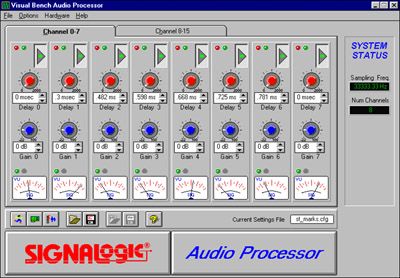Audio Processor Software

The Audio Processor system is a combined software and multichannel hardware system which applies
real-time DSP effects to audio and acoustic applications. The system uses one of several DSP/data
acquisition hardware possibilities to apply real-time processing to multichannel analog input,
and produce desired analog output. The maximum number of channels ranges from 8 to 128 channels
per system, depending on DSP hardware type being used, and factors such as required dynamic range
and SNR. Audio and acoustic processing capabilities include multiple arbitrary FIR filter shaping,
delay lines, equalization filters, feedback detection and filtering, various types of monitoring
(clip, level, signal integrity, etc.) and user-defined DSP algorithms.
Applications
Applications include improving speech and audio intelligibility in auditoria, steering sound,
dynamically "shaping" frequency response, monitoring acoustic conditions, and applying DSP
algorithms (filters, adaptive equalization, FFTs, etc.) in real-time.
Although many such systems exist in the acoustic and audio marketplace, some things which make the
Signalogic system different include the tremendous flexibility and adaptability of DSP technology,
low-cost, multiple choices of analog I/O type and DSP type, user-defined expansion and DSP
programming, and the ability to access and communicate with DSP code from a number of host
environments, including MSVC, Visual Basic, LabVIEW, and MATLAB.
Audio Processor features include:
- multichannel operation (from 8 channel to 128 channel)
- independent FIR filter shaping, on per-channel basis; filtering can be implemented from 10
to 64 taps per channel, depending on sampling rate and other processing requirements; filters can
be completely
arbitrary in shape (designed using Hypersignal or DirectDSP software); filter coefficients can
be fixed or downloaded dynamically under GUI control
- independent delay control, on per-channel basis; delay can be controlled from 5-20 usec to
2000 msec, in 5-20 usec increments (increment depends on hardware type)
- minimum constant group delay of less than 10 usec to 5 msec, depending on hardware type and
FIR filter specifications
- independent input gain and output attenuation control, on per-channel basis; gain is
specified from 0 to 22 dB and attenuation from 0 to -22 dB (gain/atten implemented in hardware;
maximum ranges depend on hardware type); no effect on DSP code real-time efficiency
- indpendent mute control, on per-channel basis
- clipping indicator, feedback indicator, level meter, and other status indicators per channel
- control of DSP hardware operating parameters, including sampling rate, number of channels,
digital scale and offset factors, real-time digital features, etc.
- wide range of DSP types and analog I/O types to choose from; over 25+ state-of-the-art
DSP/data acq. hardware is supported (see comments below)
- standard Visual Bench software feature set, including settings
(personality) save/retrieve, hardware type/driver selection interface, numerous options and user
preferences, client customization and re-sale features, etc.
- fully compatible with DirectDSP® software
for system development, system expansion, and DSP algorithm development purposes
Because of the numerous DSP/data acquisition boards supported by Signalogic software, a wide
variety of DSP boards with different analog I/O capabilities is possible. Examples include
32-channel sigma-delta (on one board), very high-quality 8-channel (24-bit sigma-delta), high
sampling rate boards (200 kHz to 1 MHz), and more. Possible DSP types include Analog Devices
SHARC, Lucent DSP32C, and Texas Instruments C3x and C4x. Support for multiple DSP types and
multiple analog I/O types which still looks uniform from an application point-of-view is a major
difference between Signalogic and other competitors in the acoustic/audio software market.
Current Installations
Current installations of the Audio Processor system include the St. Marks Cathedral in Seattle,
Washington. In the St. Marks application, the software is used to precisely control arrival of
wavefronts from multiple speakers, in order to create the desired audience perception of sound
arrival and direction, regardless of speaker placement dictated by building architectural and
aesthetic considerations.
 The Audio Processor system is a combined software and multichannel hardware system which applies
real-time DSP effects to audio and acoustic applications. The system uses one of several DSP/data
acquisition hardware possibilities to apply real-time processing to multichannel analog input,
and produce desired analog output. The maximum number of channels ranges from 8 to 128 channels
per system, depending on DSP hardware type being used, and factors such as required dynamic range
and SNR. Audio and acoustic processing capabilities include multiple arbitrary FIR filter shaping,
delay lines, equalization filters, feedback detection and filtering, various types of monitoring
(clip, level, signal integrity, etc.) and user-defined DSP algorithms.
The Audio Processor system is a combined software and multichannel hardware system which applies
real-time DSP effects to audio and acoustic applications. The system uses one of several DSP/data
acquisition hardware possibilities to apply real-time processing to multichannel analog input,
and produce desired analog output. The maximum number of channels ranges from 8 to 128 channels
per system, depending on DSP hardware type being used, and factors such as required dynamic range
and SNR. Audio and acoustic processing capabilities include multiple arbitrary FIR filter shaping,
delay lines, equalization filters, feedback detection and filtering, various types of monitoring
(clip, level, signal integrity, etc.) and user-defined DSP algorithms.



